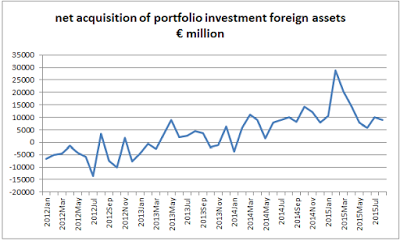In response to Eurozone Target2 Imbalances Creeping Back Up, I received a nice email from Dr. Eric Dor, Director of Economic Studies at IESEG School of Management (Lille and Paris France) regarding the imbalances in Italy.
Eric Dor Writes ...
Hello MishSince August 2014 the target2 liabilities of the bank of Italia to the Eurosystem are again on an upward trend. They have increased by € 105.3 billion since July 2014.
This increase contrasts with the downward trend that had been observed from September 2012 to July 2014 following the announcement of the OMT by ECB that had discouraged speculation and considerably dampened the capital flight out of the periphery of the euro area.
Italy has a relatively stable current account surplus, increasing Tarhet2 liabilities reflect a surge of financial outflows in the balance of payments.
It is therefore useful to examine the balance of payments of Italy to find out the exact cause of the recent surge of the Target2 liabilities of the Bank of Italia. Data of the balance of Payments have been published until August 2015. Over the 12 months from September 2014 to August 2015, the target2 liabilities of the Bank of Italia have been consistently increasing. It is therefore useful to compute the cumulated flows of the balance of payments of the country over this period.
Over this 12 months period domestic investors have bought foreign securities for an amount of €149 billion! This huge acquisition of portfolio investment foreign assets that was such a large financial outflow that it exceeded the net inflows of the current account surplus, the capital account surplus, and many other items of the financial account.
Huge financial outflows to buy foreign securities are thus the explanation of the recent increase of the liabilities of the bank of Italia to the Eurosystem. This observation can be confirmed by examining the flows of the balance of payments over the 12 months period from August 2013 to July 2014, during which the target2 liabilities of the bank of Italia consistently decreased.
When domestic investors sell government bonds, the proceeds increase their deposits on their bank accounts. In counterpart the reserves of domestic banks increase on the liability side of the balance sheet of the local central bank.
It is thus clear that Italian investors, having sold Italian bonds to the Bank of Italia, partially used the money they received to purchase foreign bonds. But it only accounts for part of the huge purchases of foreign securities by Italian investors since August 2015. The increase of net purchases of foreign securities by domestic investors started well before the beginning of the implementation of the QE policy.
It is interesting to observe that the Eurosystem has recently purchased government bonds issued by Italy to other domestic investors than the banks of the country, in the context of the QE. Indeed Italian banks have increased their holdings of national government bonds during the period starting from August 2014 Banks keep their government bonds because they are useful collateral to obtain funding from the Eurosystem if needed, and because of regulation incentives.
Capital Flight
The above synopsis was a condensed version of a detailed and much appreciated email from Eric Dor.
The issue is an important one. Target2 imbalances represent capital flight.
Despite enormous QE measures by ECB president Mario Draghi, capital flight from the periphery to Germany is high and rising.



